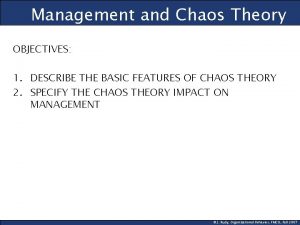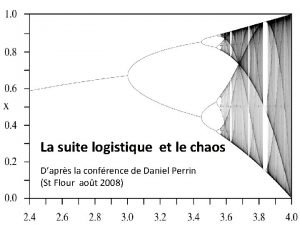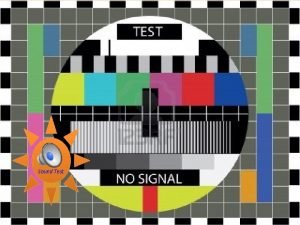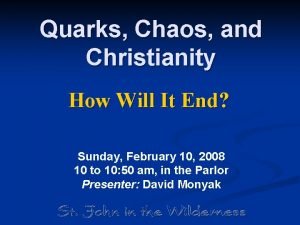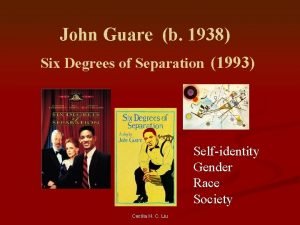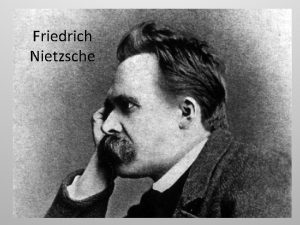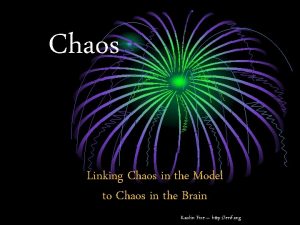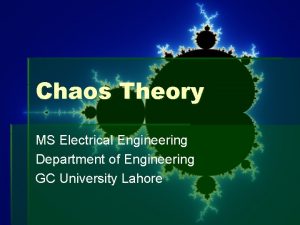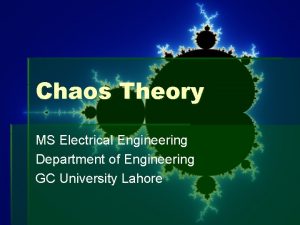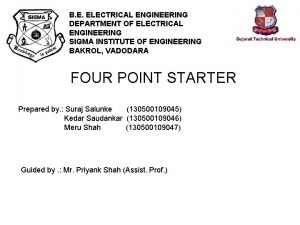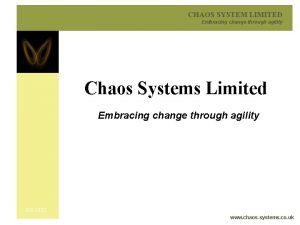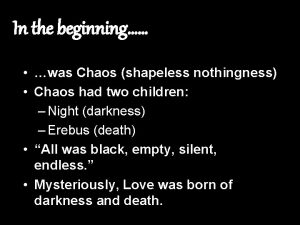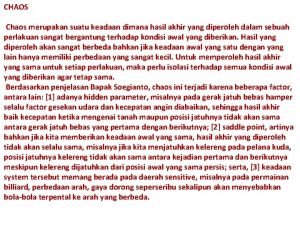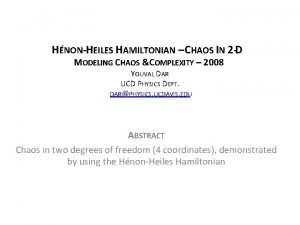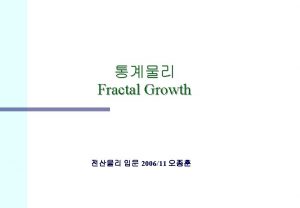Chaos Theory MS Electrical Engineering Department of Engineering




















- Slides: 20

Chaos Theory MS Electrical Engineering Department of Engineering GC University Lahore

Course Contents § § § Introduction Flows on the line Bifurcations Flows on the circle Linear Systems Phase Planes Limit Cycles Lorenz Equation One dimensional Maps Fractals Strange Attractors

Books “NONLINEAR DYNAMICS AND CHAOS With Applications to Physics, Biology, Chemistry, and Engineering”, STEVEN H. STROGATZ “CHAOS AND NONLINEAR DYNAMICS: An Introduction for Scientists and Engineers”, Robert C. Hilborn “The illustrated Dictionary of NONLINEAR DYNAMICS AND CHAOS”, Tomasz Kapitaniak, Steven R. Bishop

Research § Chaos, An Interdisciplinary Journal of Nonlinear Science § International Journal of Bifurcation and Chaos § Chaos, Solitons and Fractals

Chaos – Meaning § § § Pronunciation: /keɪɒs/noun complete disorder and confusion Example: “snow caused chaos in the region” Physics: the property of a complex system whose behaviour is so unpredictable as to appear random, owing to great sensitivity to small changes in conditions. § the formless matter supposed to have existed before the creation of the universe. § Reference: Oxford Dictionary

Probabilistic vs Deterministic § Random § Deterministic

Static vs Dynamic § Static Systems § Dynamics: Subject that deals with change § systems that evolve in time, settles down to equilibrium, keeps repeating in cycles, or does something more complicated

Brief History of Dynamics § 17 th Century – Newton solving Two-Body Problem (Sun & Earth) using Differential Equations and Law of Gravitation § Three-Body Problem (Sun, Moon and Earth) – N o explicit solution § Late 19 th Century – Poincare – Qualitative Solution rather than Quantitative, Geometric Approach § Dynamics restricted to Nonlinear oscillators in radio, radar, phase-locked loops, and lasers § Lorenz's discovery in 1963 of chaotic motion on a strange attractor – Weather Model: Aperiodic, very sensitive to Initial Conditions

Types of Dynamical Systems § Differential equations: the evolution of systems in continuous time, whereas iterated maps arise in problems § Iterated maps (Difference equations): time is discrete

Differential Equations LINEAR

Differential Equations § Exponential Growth of population of organisms

Differential Equations NONLINEAR

Trajectory & Phase-Space Draw the trajectories without actually solving the system

Non-autonomous Systems § Time Dependent Systems

Dimension of the Phase Space § n = 1: Growth, Decay or Equilibrium e. g. RC Circuit (Linear), Logistic Equation (Nonlinear) § n = 2: Oscillations e. g RLC Circuit (Linear), Pendulum (Nonlinear) § n >= 3: Three-Body Problem, Chaos & Fractals (Nonlinear)

Example:

Example (Continued)

Application Areas § § § Mathematics Biology Computer science Economics Engineering Finance Philosophy Physics Politics Population dynamics Psychology

Chaos in Electrical Circuits

Chaos in Electrical Circuits § Secure Communication
 Electrical engineering department
Electrical engineering department Tum
Tum Ucla electrical engineering
Ucla electrical engineering Chaos theory jurassic park
Chaos theory jurassic park Chaos theory management
Chaos theory management Chaos theory and cryptology
Chaos theory and cryptology Engineering elegant systems: theory of systems engineering
Engineering elegant systems: theory of systems engineering Engineering elegant systems: theory of systems engineering
Engineering elegant systems: theory of systems engineering Na początku był chaos biblia
Na początku był chaos biblia Chaos knock out geschmack
Chaos knock out geschmack Marduk in the bible
Marduk in the bible Fonction logistique chaos
Fonction logistique chaos Stamboom van de griekse goden
Stamboom van de griekse goden Single parent family tree
Single parent family tree What animal represents chaos
What animal represents chaos Copyright chaos
Copyright chaos Chaos sound test
Chaos sound test Quarks chaos and christianity
Quarks chaos and christianity Kandinsky chaos control
Kandinsky chaos control Nihilists
Nihilists Chaos ruled ok in the classroom
Chaos ruled ok in the classroom




